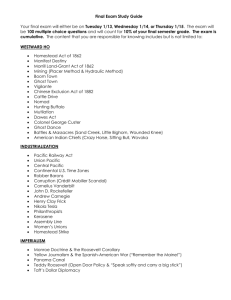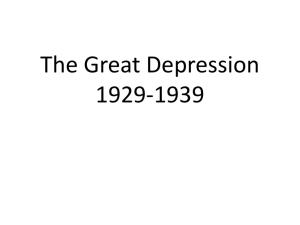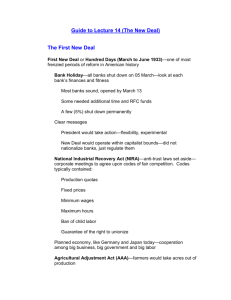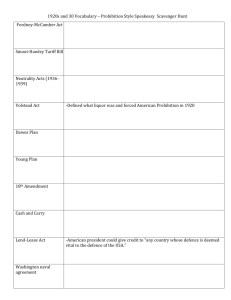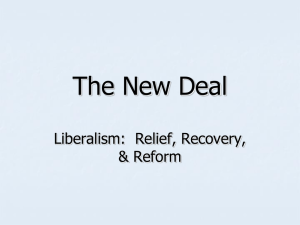File - Armada High School US History Part II
advertisement
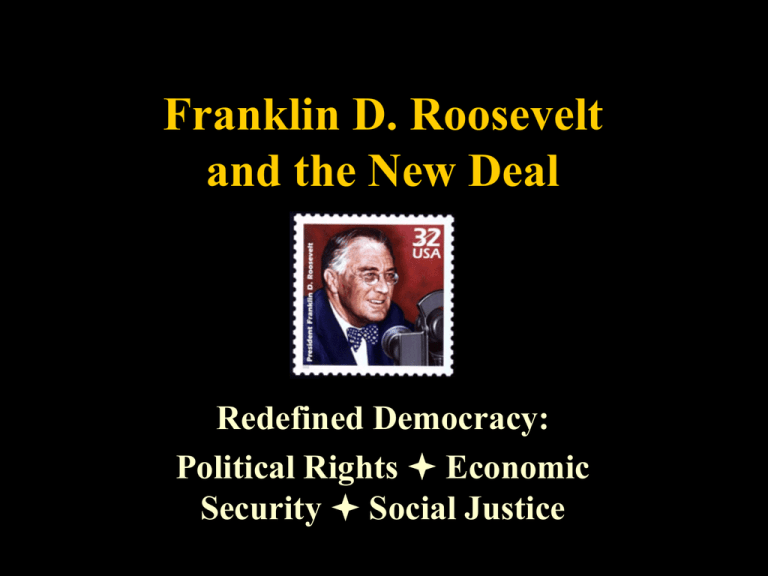
Franklin D. Roosevelt and the New Deal Redefined Democracy: Political Rights Economic Security Social Justice Causes of the Great Depression Agricultural overproduction Industrial overproduction Unequal distribution of wealth Over-extension of credit International economic situation How Herbert Hoover Dealt with the Crisis He played the game of confidence economics and just kept saying: “Prosperity is right around the corner.” Voluntary Measures Hoover eventually established two privately-funded organizations: The National Credit Association provided $1/2 billion to businesses for emergency loans, but it was too under-funded to do much good. The Organization for Unemployment Relief was a clearing house for relief agencies. However, state and local governments were already in too much debt to benefit from it. Limited Government Intervention In the end, Hoover resorted to government intervention: The Reconstruction Finance Corp gave $1-1/2 billion in federal loans to banks, insurance companies, and industry to prevent bankruptcies, but it was too little, too late. The Home Loan Bank Act provided federal loans to homeowners to prevent foreclosures, but got bogged down in red tape. Reasons for Ineffectiveness Hoover thought business should be self-regulating. He had a mania for a balanced budget. He lacked political finesse. Franklin D. roosevelt’s Appeal In 1932 presidential election, FDR was perceived as a man of action. Hoover was viewed as a “do-nothing president.” Norman Thomas, the Socialist candidate, was viewed as a radical. Results: a landslide for Democrats and a mandate to use government as an agency for human welfare. Situation When FDR Entered Office In March 1933, the country was virtually leaderless and the banking system had collapsed. FDR Restored Confidence In his inaugural address, he said “The only thing we have to fear is fear itself….” He promised vigorous leadership, bold action, called for discipline & cooperation, expressed his faith in democracy, and asked for divine protection and guidance. FDr’s Personal Qualities He was a practical politician who practiced the art of the possible. He was a charismatic person who exhibited a warmth and understanding of people. He knew how to handle press by focusing attention on Washington. He provided dynamic leadership in a time of crisis. He was willing to experiment Purposes of the New Deal Relief: to provide jobs for the unemployed and to protect farmers from foreclosure Recovery: to get the economy back into high gear, “priming the pump” Reform: To regulate banks, to abolish child labor, and to conserve farm lands Overall objective: to save capitalism Sources of New Deal Ideas Brains Trust: specialists and experts, mostly college professors, idea men New Economists: government spending, deficit spending and public works, government should prime economic pump Roosevelt Cabinet: included conservatives, liberals, Democrats, Republicans, inflationists, antiinflationists -- often conflicting, compromising, blending ideas First New Deal (1933-1934) Emphasis: reform Political Position: conservative Primary aim: economic recovery Philosophy: economic nationalism and economic scarcity (i.e., raise prices by creating the illusion of scarcity) Objectives: higher prices for agriculture and business Beneficiaries: big business and agricultural business Civilian Conservation Corp (CCC) Purpose: relief Gave outdoor work to unemployed men between the ages of 17 and 23. They received $30 per month, but $22 went back to the family. To get young men off the streets and into healthful surroundings. They built roads, bridges, dams, reared fish and distributed them into river and streams, planted trees, fought forest fires and eradicated diseases from pests and forests. The Tennessee Valley Authority (TVA) May 18, 1933 The TVA developed fertilizer and taught farmers how to improve crop yields. The biggest impact came from the electricity generated by TVA made dams. 1st Agricultural Adjustment Act (AAA) May 12, 1933 Purpose: the recovery of agriculture Paid farmers who agreed to reduce production of basic crops such as cotton, wheat, tobacco, hogs, and corn. Money came from a tax on processors such as flour millers and meat packers who passed the cost on to the consumer. Agricultural Adjustment Administration (AAA) May 12, 1933 Set crop quotas & prices based on 1909-14, Worked through state & local officials, so benefits went to middle & upper class Declared unconstitutional by Supreme Court in U.S. v. Butler (1936), Emergency Farm Mortgage Act (May 12, 1933) allowed refinancing of farm mortgages, Federal Emergency Relief Administration (FERA) MAY 12, 1933 Purpose: relief Gave money to states & municipalities so they could distribute money, clothing, and food to the unemployed. National Recovery Act (NRA) Purpose: recovery of industry Created a partnership of business, labor, and government to attack the depression with such measures as price controls, high wages, and codes of fair competition. National Recovery Administration (NRA) June 16, 1933 N.R.A. meant to be centerpiece of New Deal –New Nationalism. Joint committees of labor, management & government created fair practice codes. Section 7(a) guaranteed union recognition. Declared unconstitutional by Supreme Court in Schecter Poultry Co. v. U.S. (1935). NRA Slogan Federal Deposit Insurance Corporation (FDIC) January 1, 1934 Guaranteed bank deposits up to $2,500 Prevented bank runs by assuring depositors that they have access to their money. Reestablished America’s faith in the banks Today, the FDIC still insures up to $250,000 & guarantees people’s savings if a bank fails. Public Works Administration (PWA) June 12, 1933 hired private contractors for large infrastructure projects Run by Secretary of the Interior Harold Ickes Spent $3.3 billion on projects like Triborough Bridge Used private contractors who hired union members & did not discriminate Civil Works Administration (CWA) November 9, 1933 This public work program gave the unemployed jobs building or repairing roads, parks, airports, etc. The purpose of this organization was to get people out of unemployment and back on their feet. Securities & Exchange Commission (SEC) 1934 Regulated the stock market to avoid dishonest practices. Investigated New York Stock Exchange’s operations. Wanted to restore investor confidence. The Second New Deal, 1935 Works Progress Administration (WPA) 1935 Made to employ millions of people in a great variety of industries. Employed 8.5 million put people to work using their existing talents Projects included everything from construction of public buildings to providing school lunches. The WPA was focused on the following provisions: •Planned Housing •Adult education (diet, baby care, health) •Art •Music •Theatre •Writers •Travel Guides •Oral History Rural Electrification Administration (REA) Created in 1935 to bring electricity to rural areas. Rural electrification was based on the belief that affordable electricity would improve the standard of living & the economic competitiveness of the family farm. Rural Electrification Administration (REA) Social Security Act (SSA) Social Security Admin. Provides pensions to elderly & disabled. Financed by flat payroll tax. Aid to Dependent Children (later AFDC) was 1st federal direct welfare program. The Banking Act (Glass-Steagall Act) 1935 Brought the Federal Reserve system under closer government control. Set restrictions on bank activities. Resettlement Act 1935 Assisted poor families and sharecroppers in beginning new farms or purchasing land. Helped farmers move to more productive farmland. The National Housing Act 1937 Gave out loans for home repairs and construction to low or moderate income families. The Farm Security Administration Initially created as the Resettlement Administration (RA) in 1935 as part of the New Deal in the United States, the Farm Security Administration (FSA) was an effort during the Depression to combat American rural poverty. Gave loans to tenant farmers The Fair Labor & Standards Act The Fair Labor Standards Act of 1938 (abbreviated as FLSA; also referred to as the Wages and Hours Bill) is a federal statute of the United States. The FLSA established a national minimum wage, guaranteed 'time-and-ahalf' for overtime in certain jobs, and prohibited most employment of minors in "oppressive child labor," a term that is defined in the statute. 1937 Recession Copyright 2000, Bedford/St. Martin’s Creating Jobs for the Unemployed CCC-Civilian Conservation Corps (March 31, 1933) put young, unmarried men to work planting trees & creating parks Almost 3 million men, aged 18-25, participated 2,650 segregated, military-style camps Paid nominal $30 a month, but point was to keep them out of the labor force FERA-Federal Emergency Relief Administration (May 12, 1933) gave grants to states to fund relief efforts Run by Harry Hopkins Set up some works programs Second New Deal (1934-1941) Emphasis: reform Political Position: liberal Primary aim: permanent reform Philosophy: international economic cooperation and economic abundance Objectives: increased purchasing power and social security for public Beneficiaries: small farmers and labor Social Security Act Purpose: reform Gave money to states for aid to dependent children, established unemployment insurance through payroll deduction, set up old-age pensions for retirees. Moderate Legislation FDR sponsored moderate legislation to silence radical opposition: Revenue Act of 1935 – Response to Huey Long. Increased taxes on large incomes and corporations. Banking Act of 1935 – Response to Coughlin. Extended federal control over private banking practices. Social Security Act of 1935 Response to Townsend. Included provisions for unemployables (dependent children, the disabled, blind), unemployment insurance, and old-age pensions. The National Housing Act The Housing Act of 1937, sometimes called the Wagner-Steagall Act, provided for subsidies to be paid from the U.S. government to local public housing agencies (LHA's) to improve living conditions for low-income families. The act builds on the National Housing Act of 1934, which created the Federal Housing Administration. Both the 1934 Act and the 1937 Act were influenced by American housing reformers of the period. U.S. Housing Authority Purpose: recovery and reform Used federal funds to tear down slums and construct better housing. National Labor Relations Act Purpose: reform Put restraints on employers and set up a National Labor Relations Board to protect the rights of organized labor to bargain collectively with employers. New Deal Gains & Losses Growth of labor unions AFL grew from 2.3 million to 6.89 million, 1933-45 CIO had 3.7 million by 1938 More women working, but often excluded from relief Blacks benefited from some programs (esp. W.P.A.) Wheeler-Howard Act (1934) reversed Dawes Act & restored tribal land & self-government Copyright 2000, Bedford/St. Martin’s Critics on the Left Father Charles Coughlin created the National Union for Social Justice Claimed New Deal really benefited wealthy, not poor charged that an international conspiracy of Jewish financiers was behind Roosevelt Dr. Francis Townshend suggested a revolving pension scheme for the elderly Sen. Huey Long (the Kingfish) wrote Every Man a King & created Share Our Wealth Clubs Called for seizing incomes above $1 million & redistributing to all families Planned to run for president in 1936 Critics on the Right Conservative Democrats formed the American Liberty League – opposed New Deal as corrupt patronage politics Hoover & Republicans labeled the New Deal “socialist” & warned of loss of personal liberty Supreme Court invalidated legislation: Schecter Poultry Co. v. U.S. - declared NRA restricted intrastate commerce & delegated legislative power to executive branch U.S. v. Butler - invalidated AAA as attempt to use taxing power to unconstitutionally regulate agriculture Court Packing Roosevelt proposed to expand the size of the court from nine to fifteen justices; if the proposal met with success, he would be able to "pack" the court with six new justices who would support his policies. Second Agricultural Adjustment Act Purpose: recovery for agriculture Paid farmers for conservation practices, but only if they restricted production of staple crops. The New Deal on Trial By 1935, political disunity was evident. There were critics on the right and the left. NEW DEAL Criticisms of Conservative Opponents Conservative opponents said the New Deal went too far: It was socialism (killed individualism) It added to the national debt ($35 billion) It wasted money on relief and encouraged idleness It violated the constitution & states rights It increased the power of the Presidency (FDR was reaching toward dictatorship, Congress a rubber stamp, independence of judiciary threatened, separation of powers shattered) Anti-New Deal Organization Conservative opponents to the New Deal had an organization called the American Liberty League. They had money but were small in numbers, so FDR was not worried. Criticisms of Radical Opponents Radical opponents said the New Deal did not go far enough. They were demagogues (rabblerousers) and had popular followings, so FDR was concerned. The Election of 1936 The Election of 1936: Made the Democratic party the majority party Created a new Democratic coalition composed of both traditional elements and new elements Showed that the American people rejected radical solutions to depression The Election of 1936 % Popular Vote Electoral Votes Democratic 60.3% 523 Alfred E. Landon Republican 36.56% 8 William Lemke 1.93% Candidate FDR Party Radical Norman Thomas Socialist Earl Browder Communist 0.41% (2.21 in 1932) 0.17 (0.25 in 1932) The Roosevelt Coalition While Republicans were still relying on their traditional base of political support (big business, big farmers, and conservatives), Democrats broadened their constituency by appealing to small farmers in the Midwest, urban political bosses, ethnic blue collar workers, Jews, intellectuals, and African Americans. Protection of New Deal Accomplishments Steps FDR took to protect New Deal accomplishments (both failed): Court-Packing Plan (proposed increasing Supreme Court from 9 to 15 members, caused in revolt in Dem. Party) Purge of the Democratic Party in the Election of 1938 (came out strongly in favor of liberal Dem. Candidates, evidence that he interfered in a state campaign, Republicans gained strength in both houses of Congress) Decline of New Deal Reform after 1937 Reasons for decline of New Deal reform after 1937: Court-packing plan made Congress irritable. Recession of 1937-38 weakened confidence in New Deal measures. Republicans gained strength in both houses. Attempted purge of Democratic party failed. Conservative Democrats were elected to office. Resentful of attempted party purge, they joined ranks with Republicans to block New Deal legislation. Increasing focus on foreign affairs. The Significance of the New Deal Physical Rehabilitation of Country Attacked soil erosion Built dams and planted trees to prevent floods Reclaimed the grasslands of the Great Plains Developed water power resources Encouraged regional reconstruction projects like the TVA and Columbia River project Human Rehabilitation Established the principle that government has responsibility for the health, welfare, and security, as well as the protection and education of its citizens Embraced social security, public health, housing Entered the domain of agriculture and labor Revitalization of Politics Strengthened executive branch Reasserted presidential leadership Revitalized political party as a vehicle for the popular will and as an instrument for effective action. Extension of Democracy Redefined the concept of democracy so that it included not only political rights but economic security and social justice as well. Maintenance of a Democratic System The New Deal maintained a democratic system of government and society in a world threatened by totalitarianism. Increased size and scope of government to meet needs of the depression Provided the leadership that enabled Congress to put through the necessary relief, recovery, and reform measures. Sponsored moderate legislation to neutralize the popularity of radical opponents Government Expenditures The total cost of the current bailout now exceeds $4.6 trillion dollars. It has cost more than all of these government expenditures combined. Figures in parentheses have been adjusted for inflation: Marshall Plan: Cost: $12.7 billion ($115.3 billion) Louisiana Purchase: Cost: $15 million ($217 billion) Race to the Moon: Cost: $36.4 billion ($237 billion) S&L Crisis: Cost: $153 billion ($256 billion) Korean War: Cost: $54 billion ($454 billion) The New Deal: Cost: $32 billion est.($500 billion est.) Invasion of Iraq: Cost: $551billion ($597 billion) Vietnam War: Cost: $111 billion ($698 billion) NASA: Cost: $416.7 billion ($851.2 billion) TOTAL: $3.92 trillion
